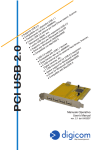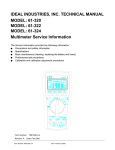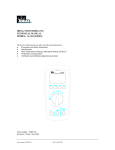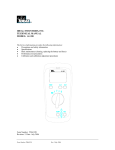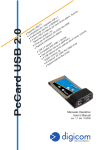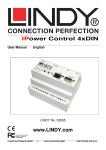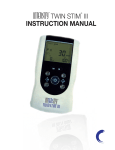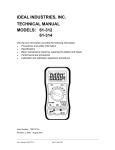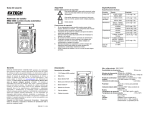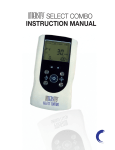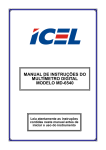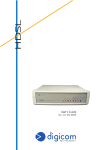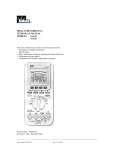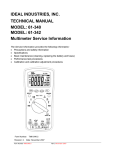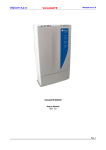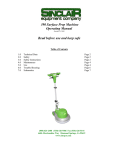Download 61-320-322-324_manua.. - IDEAL INDUSTRIES, INC.
Transcript
IDEAL INDUSTRIES, INC. TECHNICAL MANUAL MODEL: 61-320 MODEL: 61-322 MODEL: 61-324 Multimeters Service Information The Service Information provides the following information: ● Precautions and safety information ● Specifications ● Basic maintenance (cleaning, replacing the battery and fuses) ● Performance test procedures ● Calibration and calibration adjustment procedures Form Number: TM61320-2-4 Revision: 3. Date: Apr 2004 Form Number TM61320-2-4 Rev 3 April 2004 TABLE OF CONTENTS Page Introduction 1 Precautions and Safety Information 1 Symbols 1 Safety 2 Specifications 3 General Specification 3 Measurement Characteristics 4 Voltage Specification 4 Current Specifications 5 Resistance, Diode Specifications 5 Continuity, Frequency, Capacitance Specification 6 Auto Power Off, Peak Hold 6 Physical and environment characteristics 7 Certification and compliance 7 Required Equipment 8 Basic Maintenance 9 Opening the Meter Case 9 Replacing the Battery 9 Testing Fuses 10 Fuses Replacement 10 Replacing Fuses 10 Cleaning 10 Performance Tests 11 Testing the Display 11 Testing the Voltage Function 12 Testing the Resistance Function 13 Testing the Capacitance Function 13/14 Testing the Diode 14 Testing the milliamp (mA) Function 14/15 Testing the microamp Function 15 Testing the Frequency 15 Testing Frequency Function 15/16 Calibration 17 Calibrating DCV, ACV Functions 17 Calibration Adjustment Points 18/19 i Form Number TM61320-2-4 Rev 3 April 2004 Introduction Warning To avoid shock or injury, do not perform the verification tests or calibration procedures described in the manual unless you are qualified to do so. The information provided in this document is for the use of qualified personnel only. Caution The 61-320 serials contain parts that can be damaged by static discharge. Follow the standard practices for handling static sensitive devices. For additional information about IDEAL INDUSTRIES, INC. and its products, and services, visit IDEAL INDUSTRIES, INC. web site at: www.idealindustries.com Precautions and Safety Information Use the Meter only as described in the Service Manual. If you do not do so, the protection provided by the Meter may be impaired. Read the “Safety Information” page before servicing this product. In this manual, a Warning identifies conditions and actions that pose hazard (s) to the user; a Caution identifies conditions and actions that may damage the Meter or the test instruments. The Symbols The symbols used on the Meter and in this manual are explained in Table A. Table A. The Symbols Risk of electric shock See instruction card DC measurement Equipment protected by double or reinforced insulation Battery Earth AC measurement Conforms to EU directives 1 Form Number TM61320-2-4 Rev 3 April 2004 SAFETY Review the following safety precautions to avoid injury and prevent damage to this product or any products connected to it. To avoid potential hazards, use the product only as specified. CAUTION: These statements identify conditions or practices that could result in damage to the equipment or other property. WARNING: These statements identify conditions or practices that could result in personal injury or loss of life. Specific precautions Use proper Fuse. To avoid fire hazard, use only the fuse type and rating specified for this product. Do not operate without covers. To avoid personal injury, do not apply any voltage or current to the product without covers in place. Electric overload. Never apply a voltage to a connector on the product that is outside the range specified for that connector. Avoid electric shock. To avoid injury or loss of life, do not connect or disconnect probes or test leads while they are connected to a voltage source. Do not operate in wet/damp conditions. To avoid electric shock, do not operate this product in wet or damp conditions. 2 Form Number TM61320-2-4 Rev 3 April 2004 SPECIFICATIONS All specifications are warranted unless noted typical and apply to the 61-320 & 61-322 & 61-324 Stated accuracies are at 23°C±5°C at less than 80% relative humidity and without the battery indicator displayed. General specifications Characteristics Description Display count 3 3/4 Numeric update rate 1.5 times / sec Polarity display Automatic Overrange display “OL” is display Low voltage indicator is indicated Automatic power-off time Automatic backslit off = 30 minutes Power source 9V×1 battery for 61-322 & 61-324; 1.5V×2 batteries for 61-320 Maximum input voltage 1000V CAT III between V and COM Maximum floating voltage 1000V CAT III between any terminal and earth ground Maximum input current 400mA between mA and COM Maximum open circuit Voltage (current inputs) 600V between mA and COM Overload protection mA connector 1A (600V) fast blow fuse. V connector V Temperature Coefficient 0.2×(Spec. Accuracy) / °C, <18°C or >28°C Battery Life Alkaline 9V 200 hours for 61-322 & 61-324 Alkaline 1.5V×2 AA size 600 hours for 61-320 ,V 3 Form Number TM61320-2-4 Rev 3 April 2004 , Ω, , , , Hz, µA Measurement Characteristics Accuracy is ±(% reading + number of digits) at 23°C ± 5°C, less than 80% R.H. (1) DC Volts Range Resolution 400.0mV 100µV 4.000V 1mV 40.00V 10mV 400.0V 100mV 1000V 1V Accuracy Over voltage protection ±(0.5% reading + 2 digit) 1000V rms Input Impedance: 10MΩ (over 1000MΩ in 400mV range). (2) AC Volts Over voltage protection Range Resolution Accuracy 400.0mV 100µV Unspecified 4.000V 1mV ±(1.3% reading + 5 digits) *1 40.00V 10mV 400.0V 100mV 750V 1V 1000V rms ±(1.2% reading + 5 digits) * 2,3 Input Impedance: 10MΩ // less than 100pF. *1 Frequency Response: 50Hz ~ 300Hz *2 Frequency Response: 50Hz ~ 500Hz CMRR / NMRR: (Common Mode Rejection Ratio) (Normal Mode Rejection Ratio) VAC: CMRR > 60dB at DC, 50Hz / 60Hz VDC: CMRR > 100dB at DC, 50Hz / 60Hz NMRR > 50dB at DC, 50Hz / 60Hz AC Conversion Type: 61-320: Average sensing rms indication calibrated to the sine wave input. 61-322 / 61-324: AC conversions are ac-coupled, true rms responding, calibrated to the sine wave input. 3 * 61-322 / 61-324 The specified accuracy is for sine wave at full scale and non-sine wave at half scale with crest factor up to 2. Crest Factor: C.F. = Peak/RMS +1.5% addition error for C.F. from 1.4 to 3 +3.0% addition error for C.F. from 3 to 4. 4 Form Number TM61320-2-4 Rev 3 April 2004 (3) DC Current Range Resolution 400.0µA 0.1µA 4000µA 1µA 40.00mA* 10µA 400.0mA* 0.1mA Accuracy Voltage Burden 5mV 2V max. ±(1.0% reading + 2 digits) 5mV 2V max. Overload Protection: mA Input : 1A (600V) fast blow fuse. (61-322 / 61-324) µA Input : 600V rms. * For 61-322 / 61-324 only. (4) AC Current (61-322 / 61-324) Range Resolution Accuracy Voltage Burden 40.00mA 10µA 5mV 400.0mA 100µA ±(1.5% reading + 5 digits) *1 50Hz ~ 500Hz 2V max. Overload Protection: mA Input : 1A (600V) fast blow fuse. AC Conversion Type: AC conversions are ac-coupled, true rms responding, calibrated to the sine wave input. *1 The specified accuracy is for sine wave at full scale and non-sine wave at half scale with crest factor up to 2. (5) Resistance Over voltage protection Range Resolution Accuracy 400.0Ω *1 0.1Ω ±(1.0% reading + 5 digits) 4.000KΩ 1Ω 40.00KΩ 10Ω 400.0KΩ 100Ω 4.000MΩ 40.00MΩ * ±(0.7% reading + 2 digits) 600V rms 1KΩ 2 10KΩ ±(1.5% reading + 5 digits) Open circuit Voltage: -1.3V approx. *1 < 5 digit of reading rolling. *2 < 2% of reading rolling. (6) Diode Check and Continuity Range Resolution Accuracy Max. Test Current Max. Open Circuit Voltage 1mV ±(1.5% reading + 5 digits) * 1.5mA 3V * For 0.4V ~ 0.8V Overload Protection: 600V rms. Continuity: Built-in buzzer sounds when resistance is less than approximately 450Ω Response time is approximately 100 msec. 5 Form Number TM61320-2-4 Rev 3 April 2004 (7) Frequency Range Resolution 4.000KHz 1Hz 40.00KHz 10Hz 400.0KHz 100Hz 4.000MHz 1KHz 300mV rms 40.00MHz 10KHz 1V rms Accuracy Overload protection Frequency: (± 0.01% + 1 digit) 600V rms Sensitivity 150mV rms * * Less than 20Hz, the sensitivity is 1.5V rms. (8) Capacitance Range Resolution 4.000nF 1pF 40.00nF 10pF 400.0nF 100pF 4.000µF 1nF 40.00µF 10nF 400.0µF Accuracy Over voltage Protection ±(3% reading + 10 digits) ±(2% reading + 8 digits) 600V rms 100nF 4.000mF * 1 40.00mF * 1 1µF 10µF ±(5% reading + 20 digits) *2 1 * In this range the reading maybe rolling within specification. *2 Specify reading < half full scale of range. (9) Auto Power Off (APO) If the Meter idles for more than 30 minutes, the Meter automatically turns the power off. (10) Peak Hold Function ACV Range Accuracy 400mV Unspecified 4.000V ±(1.5% reading + 300 digits) *2 40.00V 400.0V ±(1.5% reading + 60 digits) 750V ACA (61-322/61-324) 40.00mA *3 400.0mA *3 ±(3% reading + 60 digits) Note: 1 With zero calibrated before measurement. *2 4V range specifies readings above 10% of full scale of range. *3 Amp range specify reading <90% of full scale of range. 4 In the noise generating field, may affect intervals. 6 Form Number TM61320-2-4 Rev 3 April 2004 Physical and Environmental Characteristics Characteristics Description Dimensions (H×W×D) 158mm×76mm×38mm 164mm×82mm×44mm (with holster) Weight (with battery) 0.3Kg With holster 0.5Kg Environmental characteristics Description Temperature operating 0 to +50°C Non-Operating -20 to +60°C Humidity (operating) <80% R.H. Altitude Operating 2,000M (6560 ft.) Non-Operating 12,300M (40354 ft.) Vibration & shock Operating MIL-T-28800E TYPE II Class 5 2.66gRMS, 5 to 500Hz, 3axes (10 minutes each) Indoor Use Indoor Use Certifications and compliances Safety Input rating Designed to ICE 1010-1, UL3111-1 and CSA specifications V / Ω/µA: Category III 1000 Volts V / Ω/mA: Category III 600 Volts CAT III: Distribution level mains, fixed installation. Over voltage category CAT II: Local level mains, appliances, portable equipment CAT I: Signal level, special equipment or parts of equipment, telecommunication, electronics. Pollution Degree 2 Do not operate in environments where conductive Pollutants may be present. EC Declaration of Conformity Meets the intent of Directive 89/336/EEC for Electtromagnetic Compatibility and Low Voltage Directive 73/23/EEC for product safety. Compliance was demonstarted to the following specifications as listed in the official Journal of the European Communites: En 55011 Class A: Radiated and Conducted Emissions. En 50082-1 Immunity: IEC 801-2 Electrostatic Discharge IEC 801-3 RF Radiated En 61010-1 Safety requirements for electrical equipment for measurement, control, and laboratory use. 7 Form Number TM61320-2-4 Rev 3 April 2004 Required Equipment Required equipment is listed in Table B. If the recommended models are not available, equipment with equivalent specifications may be used. Repairs or servicing should be performed only by qualified personnel. Table B. Required Equipment Equipment Calibrator Required Characteristics AC Voltage Range: 0 ~ 750V AC Accuracy: ±0.07% (Basic) Frequency Range: 40 ~ 1KHz Accuracy: ±2% DC Voltage Range: 0 ~ 1000V DC Accuracy: ±0.006% (Basic) Current Range: 0 ~ 10A Accuracy: AC (40Hz to 1KHz): ±0.08% (Basic) DC: ±0.02% (Basic) Frequency Source: 5.00Hz ~ 100MHz Accuracy: ±0.001% Amplitude: 0.5V p-p ~ 1.0V p-p (square wave) Accuracy: ±5% Resistance Range: 1Ω ~ 100MΩ Accuracy: ±0.03% (Basic) Capacitance Range: 1pF ~ 10mF Accuracy: ±0.10% (Basic) 8 Form Number TM61320-2-4 Rev 3 April 2004 Recommended Model Fluke 5500 or Wavetek 9100 Calibrator or equipment Basic Maintenance Warning To avoid shock, remove the test leads and any input signals before opening the case or replacing the battery or fuses. Opening the Meter Case Caution To avoid unintentional shock circuit, always place the uncovered Meter assembly on a protective surface. When the case of the Meter is open, circuit connections are exposed. To open the Meter case, refer Figure 1 and do the following: 1. Disconnect test leads from any live source, turn the rotary switch to OFF, and remove the test leads from front terminals. 2. Remove the battery door by using a flat-blade screwdriver to turn the battery door screws turn counter-clockwise. 3. The case bottom is secured to the case top by four screws and two internal snaps (at the LCD end). Using a Phillips-had screwdriver, remove the four screws. Replacing the Battery The Meter is powered 1.5V x 2 batteries for 61-320 and a single 9V battery for 61-322 / 61-324. To replace the battery, refer to Figure 9 Form Number TM61320-2-4 Rev 3 April 2004 Testing Fuses To test the internal fuses of the meter. 1. Turn the rotary selector switch to the Ω position. 2. To test FS1, plug a test lead into VΩHz input terminal, and touch the probe to the mA input terminal. The display should indicate between 0.0 to 0.2Ω. FS1 (1A 600V) (Bussmann BBS-1 recommended). If display reads higher than 0.2Ω, replace the fuse. Fuse Replacement Refer to the following figure to replace fuse: Use only a fuse with the amperage, interrupt, voltage, and speed rating specified. Fuse rating: 1A, 600V, Fast Replacing Fuses Warning To avoid electrical shock, remove the test leads and any input signals before replacing the battery or fuses. To prevent damage or injury, INSTALL ONLY quick acting fuses with the following Amp/Volt current interrupt rating : FS1 Fuse : 1A, 600V, FAST. Minimum interrupt rating 10,000A Cleaning Warning To avoid electrical shock or damage to the Meter, never allow water inside the case. To avoid damaging the Meter’s housing, never apply solvents to the Meter. 10 Form Number TM61320-2-4 Rev 3 April 2004 Performance Tests The following performance tests verify the complete operability of the Meter and check the accuracy of each Meter function against the Meter’s specifications. Accuracy specifications are valid for a period of one year after calibration, when measured at an operating temperature of 18°C to 28°C and a maximum of 80% relative humidity. To perform the following tests, it is not necessary to open the case, no Adjustments are necessary, merely make the required connections, apply the designated inputs, determine if the reading on the Meter display falls within the acceptable range indicated. If the Meter fails any of these tests, it needs calibration adjustment or repair. Testing the Display Press “HOLD” key while turning the Meter on from the “OFF” position to hold the display in the Display Test Mode. Compare the display with the example in Figure 2. Turn off the meter to escape the test mode. LCD Graphics 61-324 Figure 2 Display Test 11 Form Number TM61320-2-4 Rev 3 April 2004 Testing the Voltage Function To verify accuracy in the AC and DC voltage ranges, do the following: 1. Turn the rotary switch to “V ” position. 2. Connect the Calibrator to the VΩ and COM inputs on the Meter. 3. Set the Calibrator for the voltage and frequency from step 1 to 8 in Table 1. 4. Compare the reading on the Meter display with the display reading shown in Table 1. 5. If the display reading falls outside of the range shown in Table 1, the Meter does not meet specification. Table 1 AC Voltage Test: Step Input Frequency Reading 1 3.000V 50Hz 2.956 to 3.044 2 3.000V 500Hz 2.956 to 3.044 3 30.00V 50Hz 29.59 to 30.41 4 30.00V 500Hz 29.59 to 30.41 5 300.0V 50Hz 295.9 to 304.1 6 300.0V 500Hz 295.9 to 304.1 7 750V 50Hz 736 to 764 8 750V 500Hz 736 to 764 6. Turn the rotary switch to “V ” position. 7. Set the calibration for the voltage from step 1 to 6 in Table 2. 8. Compare the reading on the Meter display with the display reading shown in Table 2. 9. If the display reading falls outside of the range shown in Table 2, the meter does not meet specification. Table 2 DC Voltage Test: Step Input Reading 1 300.0mV 298.3 to 301.7 2 -300.0mV -298.3 to -301.7 3 3.000V 2.983 to 3.017 4 30.00V 29.83 to 30.17 5 300.0V 298.3 to 301.7 6 1000V 993 to 1007 12 Form Number TM61320-2-4 Rev 3 April 2004 Testing the Resistance Function To verify the accuracy of the resistance function, do the following: 1. Connect the Calibrator to VΩHz and COM on the Meter. 2. Turn the rotary switch to Ω. 3. Apply the inputs for step 1-6 in Table 3. 4. Compare the Meter display readings to the display readings in Table 3. 5. If the display reading falls outside of the range shown in Table 3, the Meter does not meet specification. Table 3 Ω Resistance Test: Step Source Reading 1 300.0Ω 296.5 to 303.5 2 3.000KΩ 2.977 to 3.023 3 30.00KΩ 29.77 to 30.23 4 300.0KΩ 297.7 to 302.3 5 3.000MΩ 2.977 to 3.023 6 30.00MΩ 29.50 to 30.50 Lead resistance on the 400Ω range is not included in error. Testing the Capacitance Function The Meter measures capacitance by charging the capacitor with a known Direct current, measuring the resultant voltage, and calculating the capacitance. If the same capacitance is measured on an impedance bridge, a different reading may result. This variance is likely to be Greater at higher frequencies. To verify the accuracy of the capacitance measuring function, do the Following : 1. Apply the Capacitor to the VΩHz and COM inputs on the Meter. For steps 1 through 7 in Table 4. 2. Turn the rotary switch . 3. Compare the reading on the Meter display to the reading in Table 4. Note : The meter selects the proper range automatically. Each measurement takes about one second per range, 5mF takes about 4.5 seconds. 4. If the display reading falls outside of the range shown in Table 4, the Meter does not meet specification. 13 Form Number TM61320-2-4 Rev 3 April 2004 Table 4 Capacitance Test: Step Source Reading 1 3.000nF 2.900 to 3.100 2 30.00nF 29.00 to 31.00 3 300.0nF 293.2 to 306.8 4 3.000µF 2.932 to 3.068 5 30.00µF 29.32 to 30.68 6 300.0µF 293.2 to 306.8 7 3.000mF 2.830 to 3.170 Checking the Diode Test Function To check the diode test function, do the following: 1. Connect the Calibrator to the VΩHz and COM inputs on the Meter. 2. Turn the rotary switch to . 3. Apply 3.000V DC. The meter display should read approx. 3.000V dc. 4. Apply a 50Ω resistor to meter, the built-in beeper alarms. Testing the milliamp (mA) Function (for 61-322 and 61-324) To verify the accuracy of AC current measurement functions, do the following: 1.Connect the Calibrator to the mA and COM inputs on the Meter. 2. Turn the rotary switch to mA 3. Apply the inputs for steps 1-4 in Table 5. 4. For each input, compare the reading on the Meter display to the reading for your Meter in Table 5. 5. If the display reading falls outside of the range shown in Table 5, the meter does not meet specification. Table 5 AC mA Test: Step Source Frequency 1 30.00mA 50Hz 29.50 to 30.50 2 30.00mA 500Hz 29.50 to 30.50 3 300.0mA 50Hz 295.0 to 305.0 4 300.0mA 500Hz 295.0 to 305.0 14 Form Number TM61320-2-4 Rev 3 April 2004 Reading 6. Turn the rotary switch to mA . 7. Set the calibration for the voltage from step 1 - 2 in Table 6. 8. For each input, compare the reading on the Meter display to the reading in Table 2. 9. If the display reading falls outside of the range shown in Table 6, the meter does not meet specification. Table 6 DC Current Test: Step Source Reading 1 30.00mA 29.68 to 30.32 2 300.0mA 296.8 to 303.2 Testing the microamp Function 1. Turn the rotary switch to µA . 3. Apply the inputs for steps 1-2 in Table 7. 4. For each input, compare the reading on the Meter display to the reading for your Meter in Table 8. 5. If the display reading falls outside of the range shown in Table 7, the meter does not meet specification. Table 7 DC microamp Test: Step Source Reading 1 300.0µA 296.8 to 303.2 2 3000µA 2968 to 3032 Testing the Frequency Function To verify the accuracy of the Meter’s frequency function, do the following: 1. Connect the Calibrator to the VΩ and COM inputs on the Meter. Note: The accuracy of the Calibrator’s frequency function must be appropriate for the specified accuracy of the Meter. 2. Set the rotary switch to Hz. 3. Set the Function Generator for the square wave voltage and frequency for steps 1-5 of Table 8. 4. Compare the reading on the Meter display with the display reading shown in Table 8. 5. If the display reading falls outside of the range shown in Table 8, the Meter does not meet specification. 15 Form Number TM61320-2-4 Rev 3 April 2004 Table 8 Frequency Test: Step Soure Level Reading 1 3.000KHz 150mV rms 2.999 to 3.001 2 30.00KHz 150mV rms 29.99 to 30.01 3 300.0KHz 150mV rms 299.9 to 300.1 4 3.000MHz 300mV rms 2.999 to 3.001 5 30.00MHz 1V rms 29.99 to 30.01 16 Form Number TM61320-2-4 Rev 3 April 2004 Calibration Procedure Recalibrate your meter: It is recommended that the multimeter be calibrated once each year. 1. Perform calibration at an ambient temperature of 23°C±2°C and a relative humidity of 73% or less. 2. Disconnect the test leads and turn the meter off Remove the test leads from the front terminals. 3. Position the meter face down. Remove the three screws from the case bottom. 4. Lift the end of the case bottom until it gently unsnaps from the case top at the end nearest the LCD. 5. Lift the circuit board from the case top. Do not remove the screws from the circuit board. (A) DCV Calibration (Adjust VR1) 1. Set the circuit board rotary switch "arrow" to the "V" position of circuit board. 2. Set the output of DC calibrator for 300.0V±0.02% and connect to VΩHz and COM input terminals on meter. 3. Using a small flat-tipped screwdriver adjust the potentiometer VR1 until the display reads 299.0 or 300.1. 4. Disconnect the DC calibrator from the meter. (B) ACV Calibration (Adjust VR2) 1. Set the circuit board rotary switch "arrow" to the "V" position of circuit board. 2. Set the output of AC calibration for 300Vrms 50Hz (61-320) 300Vrms 50Hz (61-322/61-324) and connect to VΩHz and COM input terminals on meter. 3. Using a small flat-tipped screwdriver adjust the potentiometer VR2 until the display reads 299.9 or 300.1 (61-320) 299.9 or 300.1 (61-322/61-324). 17 Form Number TM61320-2-4 Rev 3 April 2004 VR1 VR2 Figure 3 61-320 Calibration Adjustment Points 18 Form Number TM61320-2-4 Rev 3 April 2004 VR1 VR2 Figure 4 61-322/324 Calibration Adjustment Points 19 Form Number TM61320-2-4 Rev 3 April 2004





















